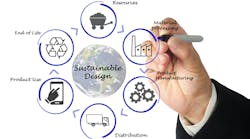1. Point 2 “Thrive boasts the lightest carbon footprint of any carpet fiber in the world etc. etc.”
This statement is not supported by any documentation. Universal claim their EPD demonstrates the superiority of their product to all the others, however they omit to quote what their own EPD declaration states, which is anyhow a general rule in the Type III environmental declarations i.e. "Comparability: EPDs are not comparative assertions and are either not comparable or have limited comparability when they cover different life cycle stages, are based on different product category rules or are missing relevant environmental impacts. EPDs from different programs may not be comparable."
Thrive EPD is based on Product Category Rules (PCR) “Textile yarn and thread of natural fibers, man-made filaments or staple fibers v.1” for NON-construction products managed by EPD International, therefore their results cannot be confronted with EPDs based on other PCRs and/or different program operators, (such as sub-oriented PCR "Synthetic carpet yarn for construction purposes", compliant with EN 15804, construction products).
2. Point 4 “Thrive is 100 percent recyclable and therefore may be up or down cycled etc. etc.”
Thrive contains other ingredients, besides polyamide, such as pigments and other not disclosed materials (5.6-6.7%), as shown on the EPD, for which there are not yet established industrial recycling processes. Therefore solution dyed yarn can only be mechanically down cycled into a product of lesser value where color does not matter and the non-polyamide materials become just “impurities” which further decrease the value and the performances of the recycled product.
3. Point 6 “Zero water is used in solution dyed fiber etc. etc.”
This statement is positively contradicted by Thrive own EPD. The Certified Environmental Facts label shows a 3% reduction in water usage (not a 100% reduction). So stating Zero water usage is obviously false. The statement will only apply to the dying process as it is not possible to manufacture any polyamide yarn without any water consumption.
4. Point 8, last paragraph “ Therefore the fiber will stay as bright and vibrant as the day they (sic) it was produced-even when exposed to UV and harsh cleaning method”
This statement is an obvious exaggeration, not supported by any certification we are aware of. It is common knowledge (and common sense) that even the strongest textile fiber in the world will eventually change its initial appearance when exposed to aggressive cleaning, UV rays and, simply, wear and tear. This is an extract of Thrive limited warranty: 10-Year Colorfastness to Light Limited Warranty: Thrive TM will not exhibit significant color change due to exposure to light. More specifically, Thrive TM will maintain a rating of three (3) or greater on the AATCC Gray Scale for Color Change. This Limited Warranty for Colorfastness to light expressly excludes exposure by direct sunlight or artificial ultraviolet light
5. Product Life Cycle Assesment (sic) 10= Best
The statement that Thrive is 20% or more better than any other product is completely unsupported by any documentation or certification. Please see the first paragraph about EPDs. Furthermore, single score result based on LCA is not supported by any international recognized standard. LCA results cannot be displayed in a cumulative way for several indicators, if there are no available rules according to which results were generated. Non transparent ratings as such are confusing for the reader.
6. Product CO2: 10=Best
This statement is confusing and nonsensical, particularly when considered with the remaining text of the advertisement. According to this graph Virgin PA66 should score the highest CO2 emissions score (10.7, even better than the best….) while Thrive will have the worst score (3.8). Once you eliminate the confusion (0 is actually the best for CO2 emissions), non-comparable data are compared, as explained above. Those data are calculated and compiled under different rules, based on different PCRs. Please see the sentence in red at the beginning of this list.


